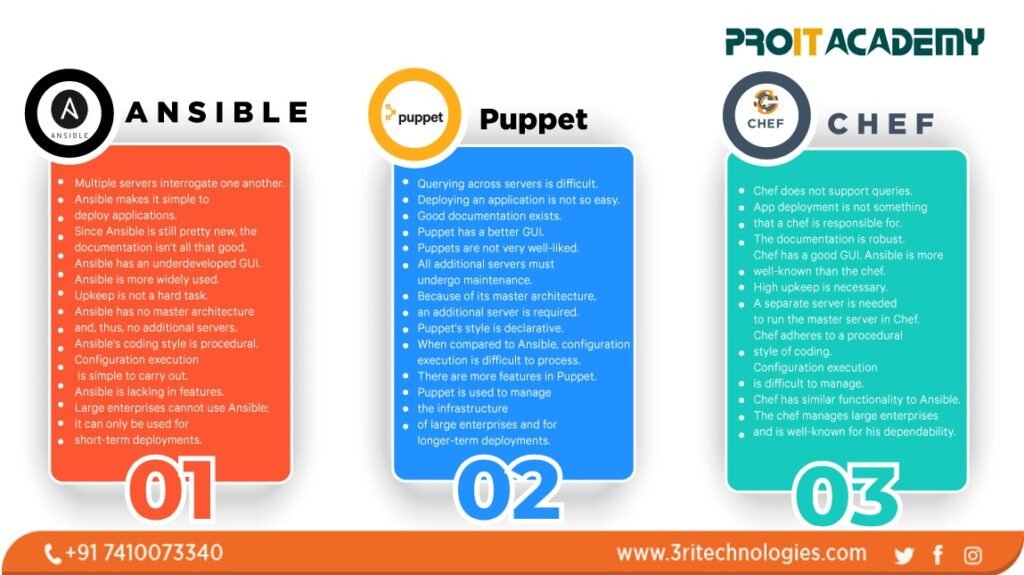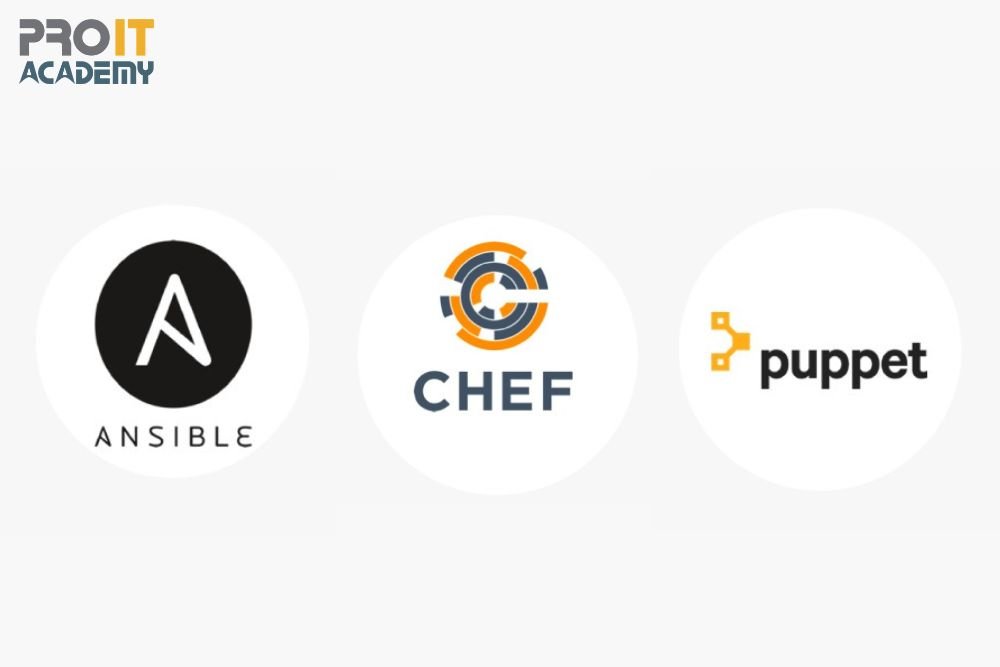In this blog post, we will delve into the world of configuration management and automation, examining three of the industry’s most popular tools: Ansible, Chef, and Puppet. The world of IT infrastructure automation is always changing, and as the demand for automation grows, so does the need for efficient and effective technologies.
These three open-source technologies have emerged as industry leaders throughout the years, assisting firms in streamlining their IT infrastructure management procedures and ensuring consistency, stability, and efficiency. The goal of this post is to compare and contrast these three tools so that you can make an informed decision about which one is best suited to the needs of your organisation. So, buckle up and get ready to learn all about Ansible vs Chef vs Puppet.
Ansible:
Ansible is a simple and lightweight automation tool that use a push-based approach. It defines tasks using YAML scripts, which are simple to understand and create even for those new to automation. Ansible is intended to be extremely adaptable, allowing IT teams to automate a broad range of processes, from the most basic to the most complex.
One of Ansible’skey strengths is its simplicity. With a simple and pretty clear syntax,Ansible makes it easy for IT teams to automate processes quickly and efficiently. Ansible is also very scalable, making it an excellent solution for companies of all sizes, from small companies to big multinationals.
Another significant advantage of Ansible is its ease of use. Unlike other automation tools, Ansible does not require a high learning curve or particular expertise to get started. This makes it a fantastic choice for IT teams new to automation as well as businesses looking for a simple and straightforward platform.
Despite its various advantages, Ansible is not without limitations. One of Ansible’s primary limitations is the lack of built-in reporting and monitoring capabilities. This means that IT teams will have to rely on third-party technology or exclusive scripts to monitor and report on the completion of automation tasks. Moreover, as Ansible lacks a centralised administration dashboard, IT teams will find it more challenging to handle many automation tasks from a single location.

Chef:
Chef is a more advanced and feature-rich application that automates using a pull-based model. Chef defines tasks using Ruby scripts, which are more difficult to read and write than Ansible. Despite its complexity, Chef is widely considered as one of the most powerful automation tools on the market, and it is best suited for big IT infrastructures and teams that require advanced capabilities like as role-based access control and reporting.
Chef’s scalability is one of its primary assets. Chef is an excellent solution for large enterprises that need to manage complex IT infrastructures since it can handle hundreds or even thousands of nodes. Chef also has reporting and monitoring tools, making it easier for IT teams to track the progress of automation tasks.
Chef’s customizable design is another notable trait. Chef is designed to be extremely modular, allowing IT teams to build customised solutions tailored to their specific needs. Chef is thus an ideal choice for companies that require complex automation workflows or specialised technology.
Chef, while it is many benefits, is not without problems. One of the main disadvantages of Chef is its complexity. Chef, with its steep learning curve and specialised expertise requirements, can be difficult to grasp for IT teams new to automation. Furthermore, Chef requires a centralised administration panel to conduct numerous automated processes, making it more difficult for IT teams to manage their infrastructure from a single location.

Book Your Time-slot for Counselling !
Puppet:
Puppet is another popular automation tool that operates on a pull-based architecture. Puppet, like Chef, works best in big IT infrastructures and is designed to automate complicated IT procedures and deployments. Unlike Chef, however, Puppet defines tasks using its own domain-specific language, making it easier to understand and write than Chef but still more difficult than Ansible.
Puppet’s centralised administration features are one of its key strengths. IT teams can simply manage various automated processes from a single place with a centralised management panel, making it easier to maintain consistency throughout the infrastructure. Furthermore, Puppet has reporting and monitoring features that allow IT teams to watch the progress of automated processes and rapidly detect any issues that arise.
Another aspect of Puppet is its scalability. Puppet, like Chef, is intended to manage large IT infrastructures containing hundreds or thousands of nodes. Puppet is thus a good choice for companies that must manage large IT infrastructures and require extensive reporting and monitoring capabilities.
Despite its many benefits, Puppet is not without limitations. One of Puppet’s major limitations is its complexity. Puppet may be difficult to understand for IT teams new to automation because to its steep learning curve and specialised knowledge. Furthermore, Puppet’s reliance on its own domain-specific language may make it more difficult for IT teams to get the tools and assistance they require when problems arise.
Chef vs Puppet
Chef and Puppet are both configuration management solutions that enable administrators to manage and automate IT infrastructure deployment. Chef’s primary language is Ruby, but Puppet has its own declarative language. Chef is more adaptable and utilises a “push” method, in which the Chef client pushes changes to nodes, whereas Puppet is more structured and uses a “pull” approach, in which nodes pull updates from the Puppet master. Chef has a larger community and more resources, although Puppet is well-known for its reliability and scalability.
Want to start your career as an AWS Certified Professional? Check out AWS With DevOps And Python Training in Pune
Ansible vs Chef
Ansible and Chef are popular technologies for automating IT infrastructure, yet they differ significantly. Ansible is well-known for its simplicity and ease of use, making it a popular choice for small to medium-sized businesses. Chef is a more advanced tool that excels in complex configurations. Ansible’s primary language is YAML, whereas Chef’s is Ruby. Ansible is known for its ease of use and simplicity, although Chef has a larger community and more resources. Ansible is more rigid and favours a “pull” approach, whereas Chef is more flexible and prefers a “push” approach. Finally, the choice between Ansible and Chef will be determined by organization particular requirements as well as the team’s skill set.
Chef vs Puppet vs Ansible

Chef and Puppet are powerful configuration management and automation tools that have been around for longer than Ansible. Chef and Puppet have more robust and complex systems, requiring a steeper learning curve. They do, however, provide a broader set of features and capabilities. Ansible, on the other hand, is known for its simplicity and ease of use, making it a popular choice for smaller enterprises and teams.
In terms of scalability, Puppet is the most scalable, making it a popular choice for large corporations. Ansible is recognised for its simplicity and ease of use, whereas Chef is known for its flexibility and scalability.
In terms of language, Chef uses Ruby, Puppet uses its own language, and Ansible uses YAML. This can also have an impact on the tool’s usability and complexity.
In terms of functionality, Chef and Puppet both offer more advanced features such as continuous delivery and infrastructure as code. Ansible is primarily focused on ease of use and simplicity, yet it still offers a wide range of configuration management and automation functions.
Finally, the choice between Chef, Puppet, and Ansible will be determined by your company’s specific needs and preferences. If you want a simple and easy-to-use tool, Ansible may be the right choice.If you need a more robust and scalable tool, Puppet or Chef may be a better fit. It is important to evaluate each tool based on your organization’s specific requirements and objectives.

Do you need help to create your career path ?
Conclusion:
In conclusion, all three tools – Ansible, Chef, and Puppet – have their own strengths, weaknesses, and use cases, making it important to understand the differences between Ansible vs Chef vs Puppet. Ansible is a lightweight and simple tool that is straightforward to use and very versatile, making it an excellent choice for enterprises of all sizes and IT teams new to automation.
Chef is a more complicated and feature-rich solution, ideally suited for big IT systems and teams that require advanced capabilities like role-based access control and reporting. Puppet is another popular automation solution for automating complicated IT operations and deployments.
It is perfect for enterprises that require centralised administration as well as comprehensive reporting and monitoring features. Chef employs Ruby, Puppet employs its own language, while Ansible employs YAML. This can have an effect on the tool’s usability and complexity.
Lastly, the decision between Chef vs Puppet vs Ansible will be determined by the organization’s and IT team’s particular needs. Ansible may be best suited to enterprises that want basic and uncomplicated automation workflows but do not require comprehensive reporting and monitoring capabilities, whereas Chef or Puppet may be a better fit for organisations that need to manage vast and complex IT infrastructures.
Finally, while deciding between Ansible, Chef, and Puppet, it is critical to analyse each tool in context of your organization‘s goals and ambitions. The best tool for your firm will be determined by aspects such as its size, scalability requirements, and ease of use preferences.
In this blog post, we have compared and contrasted Ansible vs Chef vs Puppet to help you make an informed decision on which tool is the best fit for your organization. Whether you are just starting out or looking to upgrade your current infrastructure automation setup, these three tools are worth considering. To master the skills from industry experts visit ProIT Academy.












